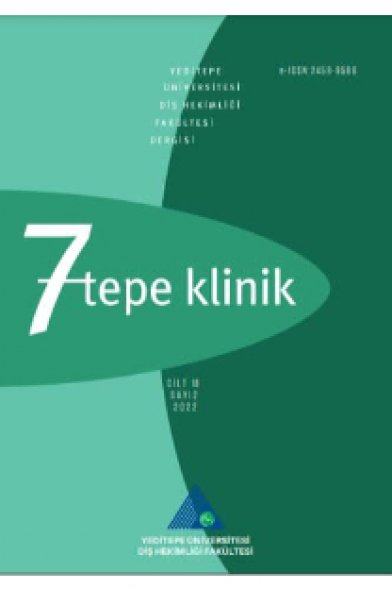Does the mixing and placement regime affect the pH of Mineral Trioxide Aggregate?
Karıştırma ve yerleştirme teknikleri Mineral Trioksit Agregatının pH değerini etkiler mi?
___
1. Gandolfi MG, Iacono F, Agee K, Siboni F, Tay F, et al. Setting time and expansion in different soaking media of experimental accelerated calcium-silicate cements and ProRoot MTA. Oral Surg Oral Med Oral Pathol Oral Radiol and Endod 2009; 108: e39-e45.2. Fridland M, Rosado R. Mineral Trioxide Aggregate (MTA) Solubility and Porosity with Different Water-to-Powder Ratios. J Endod 2003; 29: 814-817.
3. Fleming GJP, Farooq AA, Barralet JE. Influence of powder/liquid mixing ratio on the performance of a restorative glass-ionomer dental cement. Biomaterials 2003; 24: 4173-4179.
4. Fleming GJP, Shelton RM, Landini G, Marquis PM. The influence of mixing ratio on the toughening mechanisms of a hand-mixed zinc phosphate dental cement. Dent Mater 2001; 17: 14-20.
5. Fleming GJP, Shortall ACC, Shelton RM, Marquis PM. Encapsulated verses hand-mixed zinc phosphate dental cement. Biomaterials 1999; 20: 2147-2153.
6. Dowling AH, Fleming GJP. Are encapsulated anterior glass-ionomer restoratives better than their hand-mixed equivalents? J Dent 2009; 37: 133-140.
7. Nekoofar MH, Adusei G, Sheykhrezae MS, Hayes SJ, Bryant ST, et al. The effect of condensation pressure on selected physical properties of mineral trioxide aggregate. Int Endod J 2007; 40: 453-461.
8. Basturk FB, Nekoofar MH, Gunday M, Dummer PM. Effect of varying water-to-powder ratios and ultrasonic placement on the compressive strength of mineral trioxide aggregate. J Endod 2015; 41: 531-534.
9. Nekoofar MH, Aseeley Z, Dummer PMH. The effect of various mixing techniques on the surface microhardness of mineral trioxide aggregate. Int Endod J 2010; 43: 312- 320.
10. Yeung P, Liewehr FR, Moon PC. A Quantitative Comparison of the Fill Density of MTA Produced by Two Placement Techniques. J Endod 2006; 32: 456-459.
11. Shahi S, Rahimi S, Yavari HR, Samiemi M, Janani M, et al. Effects of Various Mixing Techniques on Push-out Bond Strengths of White Mineral Trioxide Aggregate. J Endod 2012; 38: 501-504.
12. Nekoofar MH, Davies TE, Stone D, Basturk FB, Dummer PMH. Microstructure and chemical analysis of blood-contaminated mineral trioxide aggregate. Int Endod J 2011; 44: 1011-1018.
13. Basturk F, Nekoofar MH, Gunday M, Dummer P. X-ray diffraction analysis of MTA mixed and placed with various techniques. Clin Oral Investig 2017: 1-6.
14. Basturk FB, Nekoofar MH, Gunday M, Dummer PM. Effect of various mixing and placement techniques on the flexural strength and porosity of mineral trioxide aggregate. J Endod 2014; 40: 441-445.
15. Santos A, Moraes J, Araújo E, Yukimitu K, Valério Filho W. Physico‐chemical properties of MTA and a novel experimental cement. Int Endod J 2005; 38: 443-447.
16. Ha WN, Kahler B, Walsh LJ. Particle Size Changes in Unsealed Mineral Trioxide Aggregate Powder. J Endod 2014; 40: 423-426.
17. Basturk FB, Nekoofar MH, Günday M, Dummer PM. The effect of various mixing and placement techniques on the compressive strength of mineral trioxide aggregate. J Endod 2013; 39: 111-114.
18. Laurent P, Camps J, De Méo M, Déjou J, About I. Induction of specific cell responses to a Ca3SiO5-based posterior restorative material. Dent Mater 2008; 24: 1486- 1494.
19. Khalil I, Naaman A, Camilleri J. Investigation of a novel mechanically mixed mineral trioxide aggregate (MM‐ MTA™). Int Endod J 2015; 48: 757-767.
20. Torabinejad M, Hong CU, McDonald F, Pitt Ford TR. Physical and chemical properties of a new root-end filling material. J Endod 1995; 21: 349-353.
21. Duarte MAH, de Oliveira Demarchi ACC, Yamashita JC, Kuga MC, de Campos Fraga S. pH and calcium ion release of 2 root-end filling materials. Oral Surg Oral Med Oral Pathol Oral Radiol Endod 2003; 95: 345-347.
22. de Vasconcelos BC, Bernardes RA, Cruz SML, Duarte MA, Padilha Pde M, et al. Evaluation of pH and calcium ion release of new root-end filling materials. Oral Surg Oral Med Oral Pathol Oral Radiol and Endod 2009; 108: 135-139.
23. Namazikhah MS, Nekoofar MH, Sheykrezae MS, Slariyeh S, Hayes SJ, et al. The effect of pH on surface hardness and microstructure of mineral trioxide aggregate. Int Endod J 2008; 41: 108-116.
24. Chng HK, Islam I, Yap AUJ, Tong YW, Koh ET. Properties of a new root-end filling material. J Endod 2005; 31: 665-668.
25. Islam I, Kheng Chng H, Jin Yap AU. Comparison of the physical and mechanical properties of mta and portland cement. J Endod 2006; 32: 193-197.
26. Torabinejad M, Hong CU, McDonald F, Pitt Ford TR. Physical and chemical properties of a new root-end filling material. J Endod 1995; 21: 349-353.
- ISSN: 2458-9586
- Yayın Aralığı: 3
- Başlangıç: 2005
- Yayıncı: Yeditepe Üniversitesi Rektörlüğü
Total dişsiz bir hastanın otojen greftleme sonrası All-on-4 konsepti ile tedavisi
Meryem Gülce SUBAŞI, Sercan KÜÇÜKKURT
Karıştırma ve yerleştirme teknikleri Mineral Trioksit Agregatının pH değerini etkiler mi?
Dilek TÜRKAYDIN, Paul DUMMER, Mohammad Hossein NEKOOFAR, Fatima Betül BAŞTÜRK, Mahir GÜNDAY
Siyah çay tüketim sıklığının ağız ve diş sağlığına etkisi
Nihat LAÇİN, Emre AYTUĞAR, İlknur VELİ
Lateral sefalometrik radyografide izlenen artifaktlar
Umut PAMUKÇU, Meryem T. ALKURT, İLKAY PEKER
Selen GÜRSOY ERZİNCAN, ŞEBNEM ALANYA TOSUN, Ebru Özkan KARACA
Diş hekimliği uygulamalarında topikal steroidler: Yan etkileri ve kullanım önerileri
Dev Wharton kanalı taşının ağız içi yaklaşımla tedavisi: Bir olgu sunumu
CANSU GÖRÜRGÖZ, Murad OSMANLI, MEHMET HAKAN KURT, Orkhan İSMAYILOV, HAKAN ALPAY KARASU
EROL CANSIZ, Yetkin Zeki YILMAZ, BAŞAK KESKİN YALÇIN, SIRMAHAN ÇAKARER, Sabri Cemil İŞLER
ZELİHA UĞUR AYDIN, KEREM ENGİN AKPINAR, CEYLAN HEPOKUR, Merve ALPAY, DEMET ALTUNBAŞ
